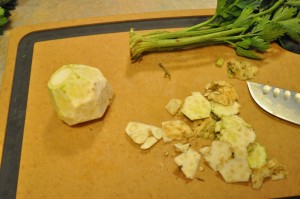Celeriac, aka celery root, is one of the lesser-known root vegetables, but we particularly like to use it when we make roasted vegetables.
It has a nice, crisp texture, and stands up well to roasting, instead of becoming mushy. It has a mild taste, similar to celery, but with a flavor that is a bit more sweet and sour. It matches up well with other roasting favorites such as carrots, sweet potatoes, turnips, and broccoli.
I don’t like celery, but I love celeriac.
Background:
Celeriac is actually the root of a specific type of celery, although it’s not simply the bottom of the stalks you normally buy. It is of a variety that is cultivated especially for the bulb or root, with the stalks being a bit smaller and less “celery-y”:
Here is the Wikipedia profile:
http://en.wikipedia.org/wiki/Celeriac
Selecting Celeriac:
Most often you will see it sold as a bulb/root only, with no trace of the greens, but sometimes you can find it sold whole. If you do find it whole, the greens look like baby celery stalks crossed with cilantro. Healthy-looking greens are a sign of fresh celeriac. If there aren’t greens, pick one that feels firm and isn’t cracked.
Benefits of Celeriac:
As an added bonus to tasting great, celeriac is relatively low in starch compared to most root vegetables, which comes in handy in winter when a seasonal diet turns more starchy.
Basic Preparation:
To prep celeriac, first chop off the greens. If they came without greens, you can usually see where the greens were attached and chop off that section:
Next, you need to chop away the rest of the surface. Celeriac has a very irregular shape, which means that a peeler won’t work very well, and it sometimes has deep pockets, where the exterior folds back in on itself:
You will want to chop all of the surface away, as well as all of the pockets, while wasting as little of the vegetable as you can. As a general rule, we buy an celeriac beyond what we think we need because, after all the trimming, you always wind up with less than you think you will:
Starter Recipes:
We like to add it to a pan of roasted vegetables. It’s also great mashed like or with potatoes. I’ve seen it pureed in soups, like this one, but haven’t tried it myself.
Enjoy!







I just learned about the existance of celariac (I’m a little slow), and found some at my farmers market to try. The gentleman who sold it to me said that you can actually eat the skin – they don’t _have_ to be peeled. Have you ever tried eating them that way? Seems like you’d really have to scrub them down. They sure are delicious – I love the citrus smell that you get from them right before the taste of the celery.
Hi Wendy,
We have never tried that. I don’t know whether I’d have the guts to.
Even when I peel vegetables, I usually try to scrub them thoroughly clean first, if for no other reason than to prevent our knives and peelers from getting dulled.
I tried scrubbing celeriac the first few times, but got nowhere. Now, I don’t even bother. I just give it a good rinse and start hacking!
Needless to say, I can’t imagine how much work it would be to get one clean enough to just bite into. Celeriac is delicious, but it’s got to be the dirtiest of all the root vegetables.
-Erik
[...] and cut into 1/2 to 1 inch cubes (see this post for [...]
[...] large celeriac (10-12 ounces), peeled and chopped into big chunks (see this post for [...]